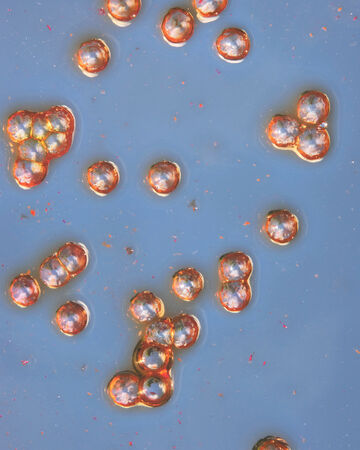
Materials and Innovation
Vision
Invest in emerging innovations that revolutionise the fashion industry as we know it through our Fabrics of the Future initiative
2023 was a pivotal year for our Fabrics of the Future initiative, which we have been running since 2019, as we launched 7 pilot products with our innovation partners.
Our priority is finding alternatives for virgin leather, wool and fibre-to-fibre technology solutions for cotton and polyester. This is based on GANNI’s carbon footprint, with 58% of our emissions coming from our material choices, with virgin leather, organic cotton, recycled polyester and virgin wool being amongst the highest emission-emitting materials. Virgin leather remains our highest emitting material in 2023, even though it only makes up for 9% of our material mix. On the other hand, organic cotton and recycled polyester make up 34% and 19% respectively, and therefore are amongst our most used materials. The difference here is important to highlight, as we had committed to a goal of phasing out the use of virgin leather by 2023, which we are proud to say was achieved. However, we are not actively trying to phase out organic cotton or recycled polyester; instead, we aim to reduce our reliance and find alternatives that have an impact on reducing our carbon footprint.
Phasing out virgin leather was a key achievement in December 2023, but it was not without its challenges and that’s why we’ve included a case study on this work below.
2024 will be an important year for scaling the Fabrics of the Future initiative. And we need to, as it’s crucial for GANNI to be able to meet its overall ambition to slash its carbon footprint by 50% by 2027 from a 2021 baseline.
GANNI Fabric Score
In order to be transparent about how we classify our materials, we are open-sourcing our GANNI Fabric Score, an internal tool we use to make informed decisions on materials that is updated annually in light of new data and insights. The GANNI Fabric Score has 3 categories:
- Preferred and Fabrics of the Future
- Better
- Avoid
To place the materials in categories Preferred, Better, Avoid in the GANNI Fabric Score, we have used GANNI’s own carbon footprint data from Plan A, the Higg MSI, and various industry reports e.g. Textile Exchange.
You can download the GANNI FABRIC SCORE here.

Materials
GOAL 14
100% of cotton, viscose, polyester and wool are category 1 ‘ Preferred’ as per the GANNI fabric score by 2023
In 2023, cotton, MMCF (Manmade Cellulosic Fibres), polyester and wool made up 73% of our total materials used.
GOAL 15
90% of all materials used are category 1 ‘ Preferred’ as per the GANNI fabric score, of that,10% of materials used are produced with Fabric of the Future innovations by 2025
GOAL 16
10% of materials used are category 2 ‘Better’ as per the GANNI fabric score with 0% ‘Avoid’ materials used by 2025
By 2025, 90% of all materials GANNI uses should be made with the ‘Preferred’ category of our Fabric Score.
Within the 90% of 'Preferred' materials, by 2025 we want 10% of those to come from Fabrics of the Future – innovations that will change the industry as we know it today. Read more about Fabrics of the Future in Goals 17 & 18.
The goal is not 100% ‘Preferred’ as we recognise that some materials used in clothing today are crucial for the construction of a product, for example, elastane, which we don’t have a readily available alternative for. Another example could be wool: if we would like a recycled wool product to have a soft hand feel, it currently needs to be mixed with conventional wool. Additionally, when we’re talking footwear and accessories, it’s an entirely different ball game; multiple components are used to create one product, so for this reason, we have a ‘Better’ category in the GANNI Fabric score.
2023 Progress
COTTON
In 2023, cotton accounted for 35% of our overall material mix. 98.6% of the cotton we used was either organic or recycled, which means that the majority of all cotton we used was classified ‘Preferred’ per GANNI Fabric Score. However, it's worth noting that organic cotton remains our second-highest carbon emitter in terms of the total weight of the material, prompting us to further explore alternatives. Besides searching for innovative fibres through our Fabrics of the Future initiative, we will focus on increasing the volume of both pre- and post-consumer recycled cotton. Lastly, we are working to bridge the 1.4% gap in conventional cotton usage. In 2023, a significant portion of our conventional cotton was sourced from recuts, leftover fabrics from our factories that were repurposed to recreate existing styles with equal value.
Organic Cotton 96.2%
Recycled Cotton 2.4%
Conventional Cotton 1.4%
Organic Cotton 98.3%
Recycled Cotton 0.2%
Conventional Cotton 1.5%
Organic Cotton 82%
Recycled Cotton 6%
Conventional Cotton 12%
MMCF (Manmade Cellulosic Fibers)
Manmade cellulosic fibers, such as viscose, rayon, lyocell, modal, cupro, or acetate, made up 5% of our overall material mix in 2023. Over two-thirds of our MMCF are now certified, with over half classified as ‘Preferred’ according to the GANNI Fabric score. Examples include LENZING™ ECOVERO™, TENCEL™ Lyocell, Acetate Naia™ and Viscose RCS. We're pleased to note that almost 2% of our MMCF mix came from our Fabrics of the Future initiative, specifically Circulose® – a cellulosic fiber made of recycled textiles like worn-out cotton jeans and cotton production scraps. At GANNI, we used viscose with Circulose® for our Future Denim pieces. On another note, MMCF remains a significant carbon emitter, with conventional MMCF constituting 30% of our mix in 2023. To bridge this gap, we will increase our usage of preferred MMCF, scale our existing partnerships, and keep exploring the implementation of recycled fibers.
Certified MMCF (Rayon FSC, Viscose FSC, Acetate Naia™, Viscose RCS, LENZING™ ECOVERO™, TENCEL™ Lyocell) 67.90%
Conventional MMCF (Viscose, Rayon, Lyocell, Modal, Rayon, Acetate) 30.20%
FOTF (Viscose made with Circulose®) 1.90%
LENZING™ ECOVERO™ Viscose, TENCEL™ Lyocell, REFIBRA™, FSC Certified, Infinna 55%
Conventional Viscose 45%
LENZING™ ECOVERO™ Viscose 27%
Conventional Viscose 73%
POLYESTER
In 2023, polyester made up 24% of our material mix, with 82.5% of all polyester used being recycled. Notably, our use of conventional polyester increased in 2023, largely due to our commitment to eliminate virgin leather from our collections. As we started with its phase-out, materials containing virgin polyester served as a substitute, given its market availability and properties. We are transitioning to recycled leather and innovative materials for this purpose, and anticipate seeing a decline in conventional polyester again soon. Additionally, while recycled polyester from PET bottles is a step forward, it remains our third-highest carbon emitter because of the volume we use in our products. To address this challenge, we turned to innovative recycling processes and are happy to see a small portion of Cycora® in our collections. Cycora® is a textile-to-textile recycled polyester sourced from post-consumer waste, which we use for our sports jerseys. Moving forward, we will focus on scaling products with Fabrics of the Future materials.
Recycled polyester 82,5%
Conventional (virgin) polyester 17%
FOTF (Cycora) 0,001%
Recycled polyester 96%
Conventional (virgin) Polyester 4%
Recycled polyester 82%
Conventional (virgin) Polyester 12%
WOOL & ANIMAL HAIR
In 2023, wool and animal hair comprised 9% of our material mix. This year, we've seen a positive shift with an increase in certified and organic wool, coupled with a decline in conventional wool and other animal hair throughout our collections. While we celebrate this progress, we recognise the potential within this material category, which is driving our commitment to increase the usage of recycled alternatives, be it wool, mohair, or cashmere. However, this ambition comes with its own set of challenges; products incorporating recycled wool often require blending with virgin wool to maintain their beloved softness. Looking ahead, we will continue exploring innovative fibre alternatives and aim to mix recycled wool with other preferred materials to ensure that 100% of our wool comes from the 'Preferred' category as per the GANNI Fabric Score.
Certified Wool (RAS, GCS, RWS, RMS) 17.3%
Organic Wool (GOTS) 13.4%
Recycled Wool (certified recycled – GRS) 42%
Conventional (virgin) Wool 27.3%
Alpaca (RAS), Merino (RWS), Mohair (RMS) 16%
Organic Wool 8%
Recycled Wool 44%
Conventional (virgin) Wool 32%
Recycled Wool 54%
Conventional (virgin) Wool 39%
RWS Merino 7%
LEATHER & LEATHER ALTERNATIVES
In 2023, leather, recycled leather and next-gen leather alternatives accounted for 12% of our overall material mix. We’re pleased to see an increase in recycled leather as well as four different Fabrics of the Future materials in the mix. In 2023, we partnered with Ohoskin, Oleago (Oleatex) and Vegea, scaling the use of innovative materials. On the other hand, 70% of our leather was virgin. Throughout the year, we worked steadily to phase out virgin leather entirely from our collections, and are pleased to announce that we successfully achieved this goal by year-end. Nevertheless, it wasn’t a straightforward journey, especially since our leather footwear was among our most popular products. From 2024 onwards, we will not source or produce virgin leather and are excited to share this progress in next year’s Responsibility Report. Meanwhile, explore our detailed case study on the phase-out process below!
Conventional (virgin) Leather 71.8%
Recycled leather 23.8%
FOTF (Mylo, Ohoskin, Oleatex, Vegea) 4.4%
Conventional virgin Leather 80%
Recycled Leather 12%
Vegea ™ 8%
MATERIAL MIX
Plant Fibers 36%
Animal Fibers & Materials 21%
MMCF (Manmade Cellulosic Fibers) 5%
Synthetics 37%
FOTF (Fabrics of the Future) 1%
Cotton 35%
MMCF (Manmade Cellulosic Fibers) 5%
Polyester 24%
Wool & Animal Hair 9%
Leather 12%
FOTF 1%
Other Materials 14%
Spotlight on Phasing Out Virgin Leather
In 2019, during our first sustainability strategy GAMEPLAN 1.0 we set a goal to phase out virgin leather in our ready-to-wear collections by 2021 and in footwear and accessories by 2023.
We made this choice based on the impact leather was having on our overall carbon footprint. For context, materials made up 58% of our carbon footprint in 2023, so this is a clear lever for us to activate when trying to reduce our impact. At the time, in 2019 only 9% of our collections used leather but this accounted for majority of our material emissions that year.
GANNI is not a leather goods company, but instead, a brand who heavily believes in the climate crisis and although we are working in the fashion industry, we believed that phasing out virgin leather would have a big impact and put serious action behind our words. It’s important to mention that virgin leather goods are a profitable category for GANNI, so this switch is, of course, also associated with some risk for the business.
When we made this goal, there were limited options for replacing virgin leather with an alternative and at the same time, some of our most loved products were made in virgin leather, including our Western Boots. So, here’s what happened:
Fabrications are custom-developed from scratch, with fibres and yarns carefully selected to achieve the desired appearance, hand feel, and volume.
The manufacturer is informed about the fabrication and style specifications so they can produce a prototype.
Quality assurance is crucial, and conducting wear tests prior to production can provide valuable insights for further refining and improving the product
Working with an external, accredited laboratory, testing is conducted to validate the fabrication and the product itself to ensure it meets internal and lab standards.
Before a product goes into larger scale production, a smaller batch is produced to ensure quality standards are met.
Full-scale production is determined by customer orders, sales volume, and prevailing market conditions.
Leather goal set
Fabric of The Future initiative launched to find alternatives
4 alternatives to virgin leather trialled (3 failed)
Launched Vegea
Process established to wear and lab test before launch
12 alternatives to virgin leather, including recycled leather trialled
Pilot project with MYLO
Switched the Cleated Boot and Buckle Ballerinas to be produced in recycled leather. All new styles designed using recycled leather and next-gen leather alternatives
In November 2023, we had some tough decisions to make as a business. Our goal of phasing out virgin leather was fast approaching and we didn’t yet have solutions for two colourways of our Western Boot – Cognac and Barbados Cherry. We couldn’t kid ourselves into thinking that we would have a solution to these colours anytime soon as there was a very specific pigment needed to produce these colours, and to date, that has only been achieved by leather.
GANNI’s leadership made a unanimous decision and took the hit, agreeing to discontinue the use of those two colourways in favour of staying true to our commitments. This resulted in a potential sales loss of DKK 2.4m (Danish Kroner).
We’re sharing this because sometimes sustainability is at odds with commerciality and that is the reality we’re facing in this current climate. In order to really make an impact – to the best of our knowledge – we have to make brave and bold decisions.
We also want to point out that our goal of phasing out virgin leather is a contentious topic and views will always differ. GANNI has taken this decision based on the best available information, which includes our own carbon footprint data, delivered by Plan A, the Higg Index MSI and various industry reports and literature. We are aware that data and insights on the fashion industry are limited and we’re open to reading and listening to insights that are grounded in third-party verified data, but for now, we are confident in our decision.


Fabrics of the Future
GOAL 17
Launch 6 Fabric of the Future innovations on the market throughout 2023
In 2023, we were pleased to say that we exceeded our goal of launching 6 Fabrics of the Future. In fact, we collaborated with seven innovators throughout the year, introducing pilot launches with six of them and successfully using one in our main collections – Circulose®. It’s important to say that while the pilot launches are important to test the market and get feedback, it’s not our goal to only pilot with these material innovations. We need them to scale and commercialise, and we would like to use them in our main collections consistently. This is harder than it sounds and we are relying on the innovators securing demand and funding. However, we want to support these material innovations as much as possible and show that these innovative materials have the potential to revolutionise the industry as we know it today.
Ohoskin (Bou Bag & Cleated Boots)
Celium by Polybion
Savian by Biofluff
Modern Synthesis
Algreens Tech (shown at CPHFW SS24 show)
Circulose by Renewcell (Denim)
Cycora by Ambercycle
GOAL 18
10% of materials used in GANNI collections are from Fabrics of the Future by 2025
As we discussed in the previous sections, this is our end goal, but it’s not easy to achieve. In 2023, Fabrics of the Future accounted for 1% of all products produced in 2023, so we have some way to go but it's a good start. The biggest reason we made it to 1% is because we managed to scale the use of Renewcell’s CIRCULOSE® fibres* into our main collections in 2023, a development we're continuing in 2024.
* Renewcell is a Swedish pulp producer that specialises in textile recycling and circular textile solutions. The company's primary focus is on transforming discarded textiles into a new material called Circulose®. Circulose® is created through a proprietary process that breaks down cotton fibres from old clothing and other textile waste into a pulp, which is then spun into new fibres. These regenerated fibres can be used to create high-quality fabrics for clothing, accessories, and other textile products.
For 2024, we have identified 11 Fabrics of the Future that we believe are closer on the journey to commercial scale. These will be our priority partnerships for the year. We hope to report more positive news in next year's report.